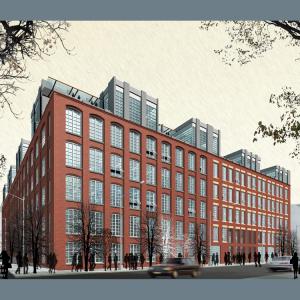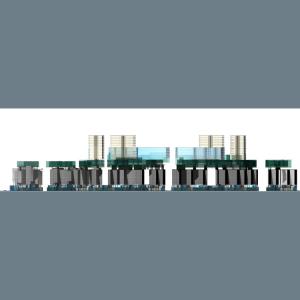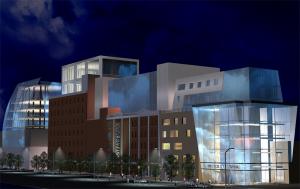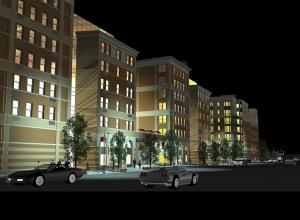





Project Manager/Designer: Robert M. Scarano jr.
Visit:









Project Manager/Designer: Yury Yagudayev, Daniel Yunatanov
Visit:










Project Manager/Designer: Alex Zhitnik, RA
Visit:
Existing buildings remain, as new flexible spaces are carved out, forming hierarchy with a base of new residential units, commercial and community spaces, existing residential units in the center, and new residences at the top. The building’s footprint features flexible spaces: inward facing amenities and residential uses, and street facing commercialcommunity spaces. A layering method of design ‘detaches’ the structures to create over 100 acres of open green space at various levels, generating new streetscapes and income, and serving as community spaces that offer interaction opportunities within the complex and with the city. The strategically skewed, “floating" residential units on the top unify the site, creating visual fluidity throughout while maximizing light, air and views. A variety of glass patterns skins these structures, mirroring the sky and East River landscape.


Project Manager/Designer: Albert Faks
Visit:
The retail corridor spans a five block retail corridor along Kings Highway, between Ocean Parkway and McDonald Avenue, and is located in the neighborhood in which Mr. Scarano was raised. For three generations Robert Scarano's family has been a part of this wonderful, global village of a community, so when some of his neighbors got together, reaching into their own pockets to improve the proverbial 'town square,' we joined them by donating our design expertise and project management services. The Scarano team, supervised by another longtime Gravesend neighbor, project manager Albert Faks, has completed many of the designs for the streetscape, which will include new sidewalks, new street furniture and classically-styled lamp posts, possibly with clocks. Sleekly modern waste receptacles have now replaced the old trash cans and already give the streets a more uniform appearance. In addition, plans are being submitted to the City for curbside planters, additional trees and, eventually, muni-meters to take the place of the rows of rag-tag parking meters that currently line the streets. A small mall at the crossroads of East Fourth and Fifth streets, featuring a colorful array of trees and flowers, was among the first projects completed last spring by the association. The addition of the mall has not only made a visual impact on the street, its location between the intersecting streets has resulted in eight more parking spaces for the area and an immediate boon to nearby businesses. Reflective of neighborhood, the local retail runs the gamut of Kosher shawarma restaurants and pizza parlors to fashion boutiques, pet stores and mom-and-pop groceries. The new plans also include public seating in strategic areas and tee guards to protect existing trees.





Project Manager/Designer: Stephen Conte
Visit:
Bringing life to a desolate industrial block is always a challege. The conceptual urban masterplan for this large parcel constitutes the feasibility study for the modernization and re-use of an entire industrial block on the industrial outskirts of the historical Clinton Hill neighborhood and in close proximity to the Brooklyn Navy Yard as a commercial complex by examining the physical and financial possibilities of converting multiple abandoned warehouses into a unified mixed-use complex of commercial, industrial, storage and public facilities. The concept for this project, because of the massive scale and impact, was to create a linear promenade that could visually unify hall from Flushing avenue to Park Avenue, and conceptually relate it to the lively, booming myrtle avenue. This allows for the flow of pedestrians along a safe route to the once desolate area. the incorporation of a major bank and retail venues will also encourage the migration of more residents to this area, further transforming the neighborhood, while keeping true to its industrial roots.


Project Manager/Designer: Alex Zhitnik, RA, Tamar Kisilevitz
Visit:
LOOP-D-LOOP pavilion serves as a springboard to further development in the Coney Island area of Brooklyn. Whether entering at grade or at the boardwalk level, visitors to this miniature oasis will be treated to the first drop of the cyclone. The rebirth of Coney Island is reflected in the journey into the sky from ground level. LOOP-D-LOOP pavilion embodies the freedom of spirit that Coney Island represented at the turn of the last century for inner city residents. The pavilion is a pedestrian attraction that can be walked through, therefore all surfaces serve as extensions of the already existing linear boardwalk and they are all accessible to pedestrians, as the site is gradually revealed through physical ascension. The building's spiraling motion, which is enhanced by children running through it, creates a theatre of interaction through its use alone. A race to the top of the building rewards the winner with an unobstructed view of the ocean, a seat from which to watch a game, a waiting area for a rider on the jump or a respite from a hectic day at the park. The most important fact to remember is that Coney Island has the power to temporarily transform anyone into a child again.







Project Manager/Designer: Robert M. Scarano jr.
Visit:
Designed as a gated community, the 320,000 square foot "Ocean Dreams" provides the style of living that dreams are made of, in a context that is hard to come by in New York City. With a construction budget of $56 million, or $175 per square foot, it is situated directly along the Riegelmann Boardwalk, and comes as close as a private property can get to the beachfront. The design for such a large development, with 320 apartments ranging from 500 square foot studios to 1800 square foot three bedroom apartments, requires an understanding of not only multi family residential design but master planning for an entirely new community as well. The design takes advantage of contextual zoning to contribute vast open spaces for outdoor recreation, and to provide tenants and the public with friendly access to the boardwalk and beach. The wide range of apartment sizes, styles and prices accommodates everyone from singles to extended families, earning the term "something for everyone" as the slogan for the development. High ceilings, on-site parking for every unit, children's and adult swimming pools and two whirlpool spas are only some of the extras offered. Most units enjoy direct ocean views through an extended bay window, while units facing south have direct access to the boardwalk and beach. The ocean, with all its majesty, is also brought into the interiors via decorative glass in the lobby, bathrooms and kitchens, adding distinct character to the entire project.











Project Manager/Designer: Robert M. Scarano jr.
Visit:
This relatively flat site encompasses the majority of a 4-acre city block in the Prospect Heights section of Brooklyn. It is in the vicinity of Prospect Park and a large concentration of hospitals and medical facilities. It is also within a high density residential zone, from which it stands apart due to its current designation as a manufacturing district. This large-scale housing project was approached on two levels: the first as an urban planning exercise and the second as an inventive design project for high-density, multi-family housing. It targets the possibilities of maintaining the residential nature of the area by adding approximately 300 housing units, thereby spurring commercial growth. The design goal is to minimize the impact that the bulk of such a large development has on a community and to achieve a dynamic sense, as though the buildings are passing through the site rather that imposed onto it. This effect is enhanced through the use of extensive grassed roofs, which look more like a large, multi-level green park rather than built masses. The configuration of the buildings responds to a study of light and shadow and offers a healthy lifestyle alternative through an abundance of natural light and air. The program includes 650,000 square feet contained within 11 levels. The key elements are three elongated, curved linear structures that interlock and rest upon a "green plinth" for the building's base, (which also includes commercial and community space). In addition, 600 parking spaces are distributed over two sub-grade levels.






Project Manager/Designer: Robert M. Scarano jr.
Visit:
A variety of housing types creates the diversity necessary to convince the City of New York to divest itself of a land that was formerly owned by the Brooklyn Union Gas Company and was later converted into a public place. Planning a large civic project in a city as unique as New York requires the support of the Mayor, City Councilman, Assemblyman, Local Political Groups, the Community Board and the City Planning Commission. With much remediation and a now cleaned Gowanus Canal behind the site, a large tract of vacant land raised public interest, typically followed by concerns of overcrowding, street congestion, and a burden on municipal services in the immediate area. To diffuse this concern, the program embraces a variety of housing styles ranging from individual town-homes and small-scale three and four-family brownstone residences, through mid-rise loft residences along the perimeter of the site, near the elevated train tracks, to a seniors assisted-living building along the canal and a block of subsidized rental apartments. A block of market-rate condominiums completes the mix and helps to stabilize financing for the overall development. All these contribute to the diversity sought by those who participated in the development process.